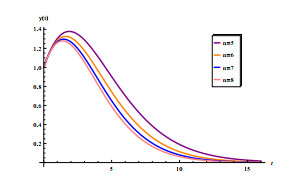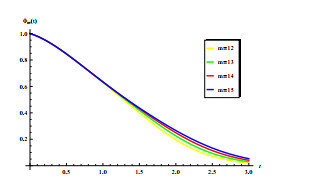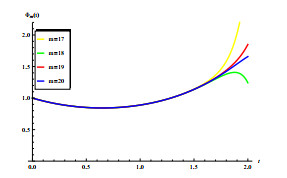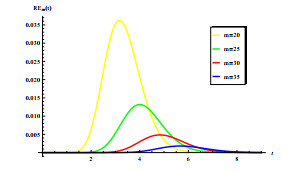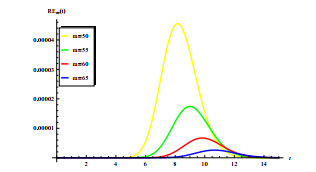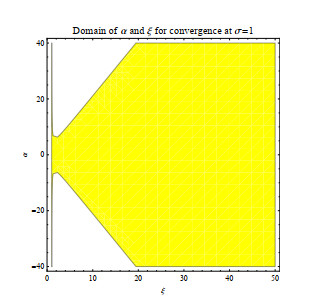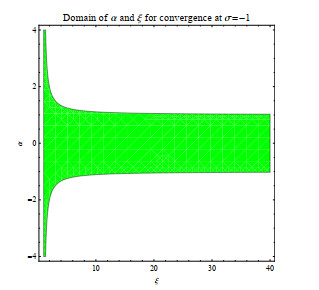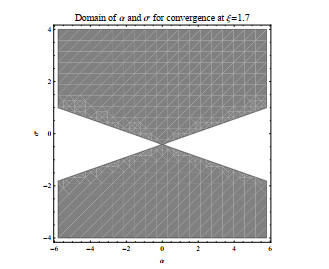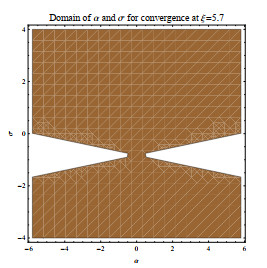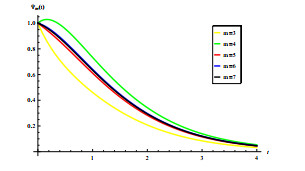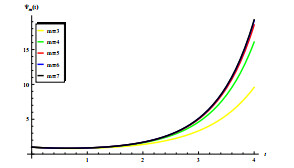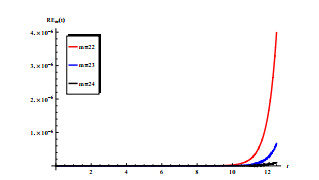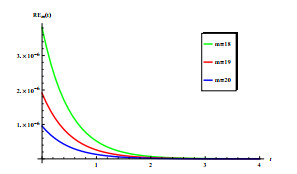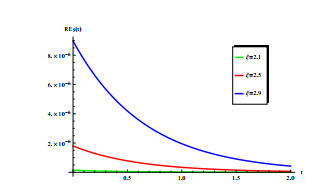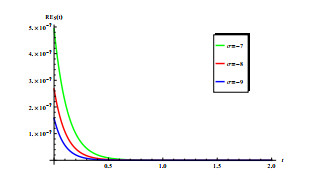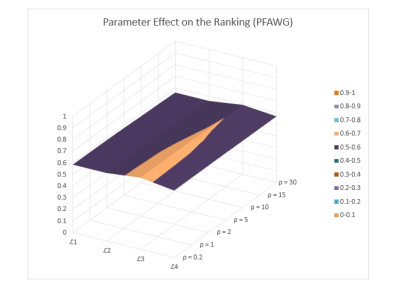1.
Introduction
The Ambartsumian equation is of practical interest in astrophysics [1]. It describes the surface brightness in the Milky Way. This paper focuses on an extended version of this equation. The extended Ambartsumian delay differential equation (EADDE) is considered in the following form:
where α, ξ, σ, and λ are constants. If σ=0 and α=1, the EADDE (1.1) becomes the standard Ambartsumian delay differential equation (SADDE):
Moreover, the case α=0 transforms Eq. (1.1) to the initial value problem (IVP) y′(t)=−y(t), y(0)=λ. Such IVP consists of a simple linear ordinary differential equation (ODE) in which the exact solution is well-known as y(t)=λe−t. When α≠0, the exact solution of the EADDE (1.1) is still unavailable. So, the main objective of this work is to report some new results in this regard. In the last decade, several techniques have been discussed and proposed for analyzing the SADDE (1.2) in classical form [2,3,4] and also in a generalized form; see, for example [5,6]. However, the EADDE (1.1) may be considered for the first time in this paper.
In order to solve the present model, there are many numerical and analytical methods that can be used. For the numerical methods, there are the Taylor method [7], Chebyshev polynomials [8], the Bernoulli operational matrix [9], Bernstein polynomials [10], spectral methods [11,12] and other numerical approaches [13,14]. The analytic methods include the Laplace transform (LT) [15,16,17], the combined Laplace transform-Adomian decomposition method [18], the double integral transform [19], Adomian's method [20,21,22], the Homotopy perturbation method (HPM) [23,24,25,26], the differential transform method [27,28], and the homotopy analysis method [29,30,31,32] and its modifications/extensions [33,34].
However, a simpler approach is to be developed in this paper to treat the model (1.1) in an analytical sense. Our procedure depends mainly on two basic steps. The first step is to produce an efficient transformation to put Eq (1.1) in a new form that contains no exponential-function coefficient. The second step is to solve the transformed equation in which the coefficients will be constants. It will be demonstrated that the transformed equation possesses the same structure as the Pantograph delay differential equation (PDDE) [35,36,37,38,39]:
where a, b, and c are constants. To the best of our knowledge, there are several available analytical solutions for the PDDE (1.3) in different forms. Such ready solutions of the PDDE are to be invested in constructing the analytical solution of the present model in different forms. In addition, it will be revealed that the exact solution of the model (1.1) is still available when specific constraints on the involved parameters are satisfied. The next section highlights the basic transformation that is capable of converting the EADDE to the PDDE.
2.
Formulation and mathematical analysis
Theorem 1. The transformation:
converts the EADDE (1.1) to
where
Proof. Suppose that
where μ is an unknown parameter to be determined later. Substituting Eq (2.4) into Eq (1.1), then
i.e.,
or
Let
then
Hence, Eq (2.7) becomes
and this completes the proof. □
Remark 1. Based on Theorem 1, we have
as a solution for the EADDE (1.1) such that z(t) is a solution of the PDDE:
where a, b, and c are defined as
and μ is already given by μ=ξσξ−1.
3.
Solutions of the EADDE
In the literature, the solutions for the PDDE (1.3) have been obtained in different forms. Two kinds of solutions were found and addressed below. The first kind expresses the solution in the form of a power series, i.e., a power series solution (PSS). The second kind uses the exponential function solution (EFS) in closed form. Both the PSS and the EFS will be implemented in this section to formulate the solution of the current model.
3.1. The PSS
In [36], the author solved the PDDE (1.3) and obtained the PSS:
Implementing the values of a, b, and c given by Eq (2.13), then Eq (3.1) yields
i.e.,
Note that ∏ik=1(−1−μ+αξ−k)=1 when i=0. Substituting (3.3) into (2.11) leads to the following solution for the model (1.1):
It should be noted that the solution (3.4) reduces to the corresponding solution of the SADDE (1.2) when σ=0 and α=1. For declaration, utilizing these values in (3.4) gives
which agrees with the obtained PSS in [2] for the SADDE (1.2). It may be important to mention that the series (3.3) converges in the whole domain for all real values of σ, α, and ξ>1. Consequently, the solution (3.4) is convergent; this issue is discussed by Theorem 2 below.
3.2. Convergence analysis
Theorem 2. For σ,α∈R, the series z(t)=λ∑∞i=0(∏ik=1(−1−μ+αξ−k))tii! has an infinite radius of convergence ∀ ξ>1 and hence the series is uniformly convergent on any compact interval on R.
Proof. Let us rewrite Eq (3.3) as
where hi is
Assume that ρ is the radius of convergence, and applying the ratio test, then
For ξ>1, we have limi→∞ξ−(i+1)=0, thus
which completes the proof. □
3.3. The EFS
In [37], the authors determined the following solution for the PDDE (1.3)
in terms of the exponential functions. Implementing the values of a, b, and c in (2.13), then the solution of the EADDE (1.1) reads
where μ=ξσξ−1 and (1/ξ:1/ξ)j is the Pochhammer symbol:
In general, (p:q)j is defined by the product:
In addition, El-Zahar and Ebaid [38] introduced the following solution for Eq (1.3)
Hence, the solution of the EADDE (1.1) is
Moreover, the authors [38] showed that the convergence of z(t) holds if the conditions |b/a|<1 and |c|<1 are satisfied. For our model (1.1), the condition |c|<1 is already satisfied for |c|=|1/ξ|<1, where ξ>1. The other condition |b/a|<1 becomes |αξ(1+μ)|<1, i.e., |α1+μ|<ξ.
4.
Exact solution at special cases
One of the main advantages of the PSS is that it can be used to generate several exact solutions at specific cases of the model's parameters. This section focuses on this issue. Before launching to the target of this section, we put the solution (3.4) in the form:
The second equation in (4.1) reveals that
This section implements Eqs (4.1) and (4.2) to determine several exact solutions of the model (1.1) under different constraints such as −1−μ+αξ−1=0, −1−μ+αξ−2=0, −1−μ+αξ−3=0, …, and −1−μ+αξ−n=0 (n∈N+).
4.1. −1−μ+αξ−1=0
From Eqs (4.1) and (4.2), it will be shown in the next theorem that only the first term v0 in series (4.1) has a non-zero value when −1−μ+αξ−1=0, while the other higher-order terms vi,i≥1 are zeros. So, the series (4.1) transforms to the exact solution for the EADDE (1.1).
Lemma 1. If −1−μ+αξ−1=0, then the EADDE (1.1) becomes
with exact solution:
Proof. Consider −1−μ+αξ−1=0; in this case we have μ=−1+αξ which implies σ=−(1−1ξ)(1−αξ) and the model (1.1) takes the form:
On using the relation μ=−1+αξ in Eq (4.2) gives vi=0 ∀i≥1. Hence, the series (4.1) contains only the first term v0 (which equals one), consequently
and this completes the proof. □
Remark 2. As a direct result of this lemma, we have at α=ξ the constant function y(t)=λ as a solution of the 1st-order delay equation y′(t)+y(t)=y(tξ) whatever the value of ξ. For a further validation of the solution (4.6), we consider the additional special case α=0. Then Eq (4.5) becomes y′(t)+y(t)=0 and the solution is derived directly by setting α=0 into Eq (4.4); this gives y(t)=λe−t which is the well-known solution.
4.2. −1−μ+αξ−2=0
This case gives the solution as a product of the exponential function and a polynomial of first degree in t.
Lemma 2. If −1−μ+αξ−2=0, then the EADDE (1.1) becomes
and the exact solution is
Proof. Let −1−μ+αξ−2=0, then σ=−(1−1ξ)(1−αξ2). Hence, Eq (1.1) yields
From Eqs (4.2), we find
and accordingly,
Inserting the values (4.10) into (4.11) completes the proof. □
Remark 3. An interesting case arises from this lemma when α=ξ2. This case implies the 1st-order delay equation y′(t)+y(t)=ξy(tξ). The corresponding solution does not contain the term of the exponential function; the solution is a pure linear polynomial given by y(t)=λ[1+(ξ−1)t].
4.3. −1−μ+αξ−3=0
Lemma 3. If −1−μ+αξ−3=0, the corresponding equation is
with the exact solution:
Proof. The proof follows immediately by repeating the above analysis. □
Remark 4. Choosing α=ξ3 yields the 1st-order delay equation y′(t)+y(t)=ξ2y(tξ) and the corresponding solution is the polynomial given by y(t)=λ[1+(ξ2−1)t+(ξ−1)(ξ2−1)t22].
4.4. −1−μ+αξ−n=0, n∈N+
This case generalizes the previous cases. The present case expresses the solution as a product of an exponential function and a polynomial of degree n.
Theorem 3. If −1−μ+αξ−n=0, the corresponding equation is
with the exact solution:
where vi is
Proof. Since −1−μ+αξ−n=0, then we have from Eq (4.1) that
which implies vi=0 ∀i≥n. Hence, vi exists ∀0≤i≤n−1. Thus, the infinite series in (4.1) is truncated to
On the other hand, vi can be rewritten as
which finalizes the proof. □
5.
Results and discussion
This section explores some numerical results for the obtained PSS and the EFS in the previous sections. The current discussion focuses on several issues, such as the behavior of the PSS and the EFS, their accuracy, the domain of the involved parameters to ensure the convergence, and also the advantages of each solution over the other. It was shown in a previous section that the PSS can be used to generate exact solutions for the EADDE (1.1) under the restriction −1−μ+αξ−n=0 (n∈N+) or, equivalently, σ=−(1−1ξ)(1−αξn). Regarding the obtained exact solution in Theorem 3, it depends mainly on n. The behavior of such exact solution is plotted in Figures 1 and 2 at different values of n. In the general case, in which the restriction σ=−(1−1ξ)(1−αξn) is not satisfied, the series form (3.4) is used to obtain the m-term approximate solution of the PSS as
Figures 3 and 4 show the convergence of the approximations Φm(t) at selected values of the parameters α, ξ, and σ, where λ=1 is fixed in all computations. These figures also indicate the difference in the behavior of the PSS when the exponent σ is changed from negative to positive. In order to estimate the accuracy of these approximations, we construct the residuals:
The numerical results displayed in Figures 5 and 6 declare that the residuals REm(t) are acceptable; especially, they approach zero as t tends to infinity. It may be important here to mention that the PSS (3.4) is convergent for all real values of α, σ, and ξ (>1) as proved by Theorem 2.
However, the situation for the EFS (3.15) is different because of the condition of convergence given by |α1+μ|<ξ, where μ=ξσξ−1. So, the m-term approximate solution of the EFS:
converges in certain domains of the parameters α, σ, and ξ. Figures 7 and 8 determine the domain of the parameters ξ and α for which the EFS converges at selected values of σ, where σ=1 in Figure 7 and σ=−1 in Figure 8. Similarly, Figures 9 and 10 show the domains of σ and α for which the EFS converges at selected values of ξ, where ξ=1.7 in Figure 9 and ξ=5.7 in Figure 10.
Figures 11 and 12 show the convergence of the approximations Ψm(t) at selected values of the parameters α, ξ, and σ. In addition, the residuals corresponding to the approximations Ψm(t) are introduced in Figures 13–16, which confirm the accuracy of the EFS.
6.
Conclusions
The extended Ambartsumian delay differential equation with a variable coefficient was analyzed in this paper. By the aid of a suitable transformation, the extended model was converted to the standard pantograph model. The available/known solutions in the literature for the pantograph model were employed to construct two kinds of analytical solutions, mainly, the power series solution PSS and the exponential function solution EFS. The PSS was successfully reformulated to generate several exact solutions for different forms of the present extended Ambartsumian model utilizing certain relations between the variable coefficient and the involved parameters. The obtained exact solutions reflect the advantage of the PSS over the EFS. Additionally, the PSS was found valid and convergent for any real values of the model's parameters. In contrast to the PSS, the EFS requires specific domains for the involved parameters to achieve the convergence criteria. However, the EFS enjoys better accuracy over the PSS. This is simply because the EFS needs a lower number of terms if compared with the EFS. However, the residuals both of the PSS and the EFS tend to zero, which reflect the effectiveness and efficiency of the developed analysis. Perhaps the suggested approach needs a further validation for applied problems such as delay-differential equations in pharmacokinetic compartment modeling [40]. Although the present extended model was analytically analyzed via a transformation approach, it may also be treated numerically via applying the randomized Euler scheme [41] as future work.
Author contributions
Rana M. S. Alyoubi: Conceptualization, methodology, validation, formal analysis, investigation, writing-review and editing, visualization; Abdelhalim Ebaid: Methodology, validation, formal analysis, investigation, writing-original draft preparation; Essam R. El-Zahar: Conceptualization, methodology, validation, formal analysis, investigation, writing-review and editing; Mona D. Aljoufi: Conceptualization, methodology, software, validation, formal analysis, investigation, data curation, writing-review and editing. All authors have read and agreed to the published version of the manuscript.
Use of Generative-AI tools declaration
The authors declare they have not used Artificial Intelligence (AI) tools in the creation of this article.
Acknowledgments
This study is supported via funding from Prince Sattam bin Abdulaziz University project number (PSAU/2024/R/1446).
Conflict of interest
All authors declare no conflict of interest in this paper.
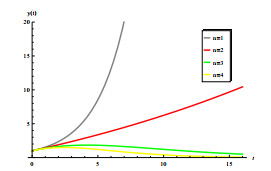









 DownLoad:
DownLoad:
